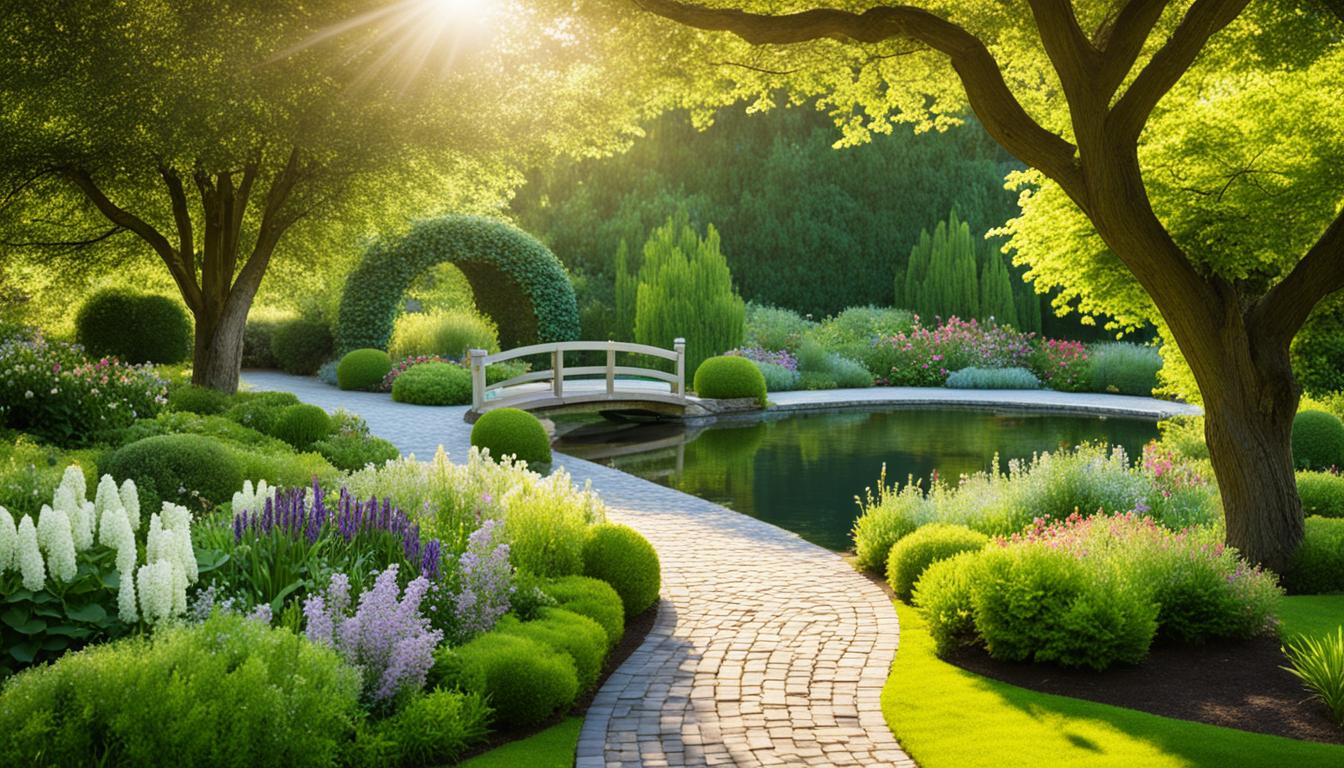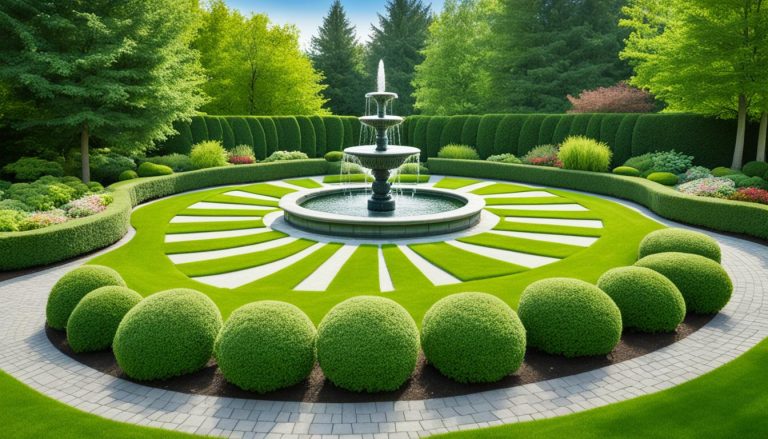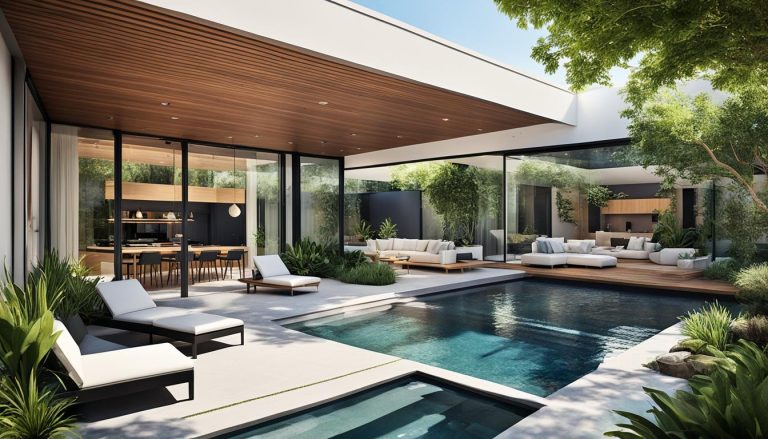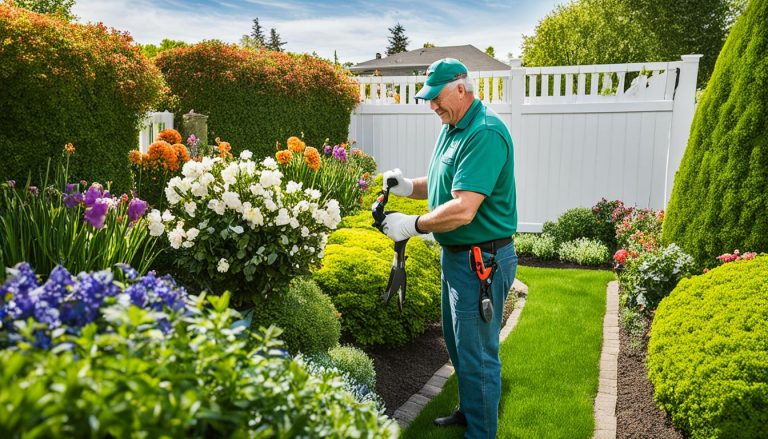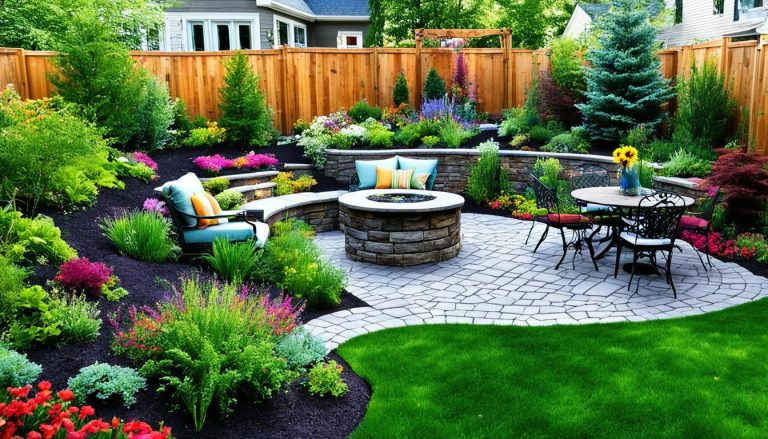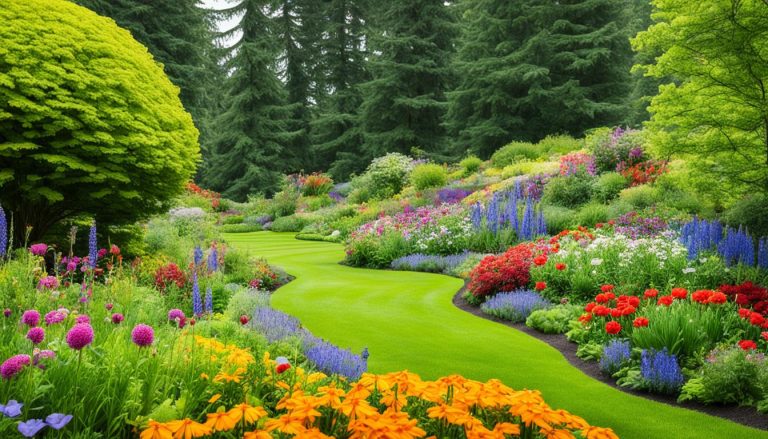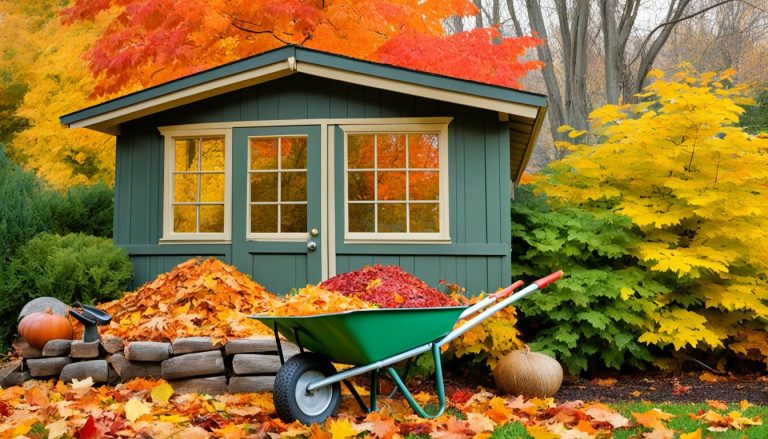Nature’s Canvas: Creative Landscaping Design Ideas
Welcome to our article on creative landscaping design ideas! If you’re looking to transform your outdoor space into a breathtaking retreat that maximizes your home’s potential, you’ve come to the right place. We’ve curated a collection of unique and innovative ideas that will inspire you to unleash your creativity and create a stunning outdoor oasis.
Whether you have a spacious backyard or a cozy urban patio, our landscaping design ideas will help you make the most of your outdoor space. From enhancing natural elements to creating functional outdoor areas, we have ideas that cater to every style and preference.
Picture your outdoor space as a blank canvas where you can create a masterpiece that reflects your personality and brings tranquility to your everyday life. Incorporating natural elements such as plants, trees, flowers, and water features can add a sense of harmony and serenity to your outdoor sanctuary. Discover how to seamlessly blend nature with your home through clever design techniques and sustainable practices.
We also understand the importance of functionality when it comes to outdoor spaces. Whether you dream of a cozy seating area for relaxed evenings or an outdoor kitchen for entertaining guests, our landscaping design ideas will help you create practical and versatile outdoor spaces that cater to your specific needs.
Even if you have a small garden, there’s no need to worry. Our landscaping design ideas for small gardens will show you how to maximize every inch of your outdoor area. From space-saving techniques to vertical gardening options, we’ll help you transform your compact garden into a vibrant oasis.
At the heart of our landscaping design ideas is sustainability. We believe in promoting environmental stewardship through our designs. Learn how to incorporate native plants, conserve water, reduce waste, and create a thriving ecosystem in your backyard. Join us in creating a sustainable landscape that benefits both you and the planet.
Lighting plays a crucial role in creating a captivating outdoor atmosphere. Our landscaping design ideas will show you different lighting techniques to achieve dramatic effects and transform your outdoor space into a mesmerizing nighttime retreat.
We understand that not everyone has the time for extensive outdoor maintenance. That’s why we’ve curated landscaping design ideas that are low-maintenance yet visually appealing. Discover plant choices, materials, and design principles that will simplify your outdoor upkeep while maintaining the beauty and charm of your landscape.
Water features add an element of tranquility to any outdoor space. Our landscaping design ideas will teach you how to incorporate various water features, such as fountains, ponds, and waterfalls, into your backyard. Immerse yourself in the soothing sound and visual appeal of water as you create a relaxing atmosphere.
Your outdoor space should be a true reflection of your style and personality. Our landscaping design ideas will help you personalize your outdoor space with custom features, artwork, themed gardens, and outdoor structures. Infuse your own creativity into your landscape design and make your outdoor space truly unique.
The first impression matters, and that’s why we’ve included landscaping design ideas that focus on maximizing curb appeal. Create an inviting and attractive front yard that leaves a lasting impression on your guests and passersby. Learn about the power of well-manicured lawns, colorful flower beds, and strategically placed landscape elements.
Enhancing Natural Elements: Landscaping Design Ideas
When it comes to landscaping design, incorporating natural elements can truly elevate the beauty of your outdoor space. By harnessing the power of plants, trees, flowers, and water features, you can create a harmonious and tranquil environment that seamlessly blends with nature.
Maximizing the potential of natural elements in your landscaping design can be a transformative experience. It enables you to connect with the soothing sights, sounds, and scents of the outdoors while creating a visually stunning retreat right in your own backyard.
One of the first steps to enhancing natural elements in your landscape design is to carefully select and position plants, flowers, and trees. Consider choosing native species that are well-adapted to your local climate. These plants not only thrive in their natural habitat but also require minimal maintenance, making them an eco-friendly choice.
In addition to selecting the right plants, incorporating water features into your landscape design can create a sense of tranquility and serenity. Whether it’s a cascading waterfall, a tranquil pond, or a charming fountain, the gentle sound of running water can transform your outdoor space into a peaceful oasis.
A clever design technique to enhance the natural beauty of your landscape is to create focal points. These can be achieved by strategically placing statues, birdbaths, or ornamental pieces amidst your plants and flowers. These elements not only add visual interest but also provide a focal point for your garden.
Sustainable practices should be an integral part of any landscape design that focuses on natural elements. Consider incorporating eco-friendly elements such as rainwater harvesting systems, permeable paving materials, and solar-powered lighting to reduce your environmental footprint while creating a beautiful outdoor space.
To inspire you further, here are some landscaping design ideas that maximize the beauty of natural elements:
- Create a vibrant flower garden with a variety of colorful native plants.
- Design a lush green wall using climbing plants or ivy.
- Integrate a soothing water feature, such as a small waterfall or a pond with water lilies.
- Build a cozy seating area surrounded by fragrant flowers and plants.
- Construct a pathway lined with natural stones or pebbles to create a serene walkway.
By enhancing natural elements in your outdoor space, you can create a landscape that is not only visually stunning but also harmonious and rejuvenating. Embrace the beauty of nature and let it inspire your landscaping design to create a breathtaking retreat right at your doorstep.
Creating Functional Outdoor Spaces: Landscaping Design Ideas
Your outdoor space has the potential to be more than just a visually appealing area. It can also serve as a functional extension of your home, providing practical and versatile spaces for various activities. In this section, we will explore landscaping design ideas that focus on creating functional outdoor spaces, optimizing your backyard or garden for your specific needs and lifestyle.
Cozy Seating Areas
A cozy seating area can transform your outdoor space into a comfortable and inviting place to relax and entertain. Consider incorporating comfortable outdoor furniture, such as lounge chairs, sofas, or hammocks. Add some cushions and throw pillows to create a cozy atmosphere. Don’t forget to provide shade with umbrellas or pergolas, ensuring you can enjoy your seating area regardless of the weather.
Outdoor Kitchens
Take your culinary skills outside with a well-designed outdoor kitchen. Whether you’re grilling burgers for a family barbecue or hosting a dinner party, an outdoor kitchen adds functionality to your space. Include appliances such as a grill, refrigerator, sink, and even a pizza oven. Design the layout to facilitate seamless meal preparation and create an enjoyable cooking experience.
Entertainment Zones
Make your outdoor space the go-to spot for entertainment by creating dedicated zones for different activities. Set up a designated area for outdoor games like cornhole or bocce ball. Install a projector and screen for outdoor movie nights, or create a cozy fire pit area for roasting marshmallows and sharing stories. Consider installing outdoor speakers to set the mood with your favorite music.
Table and Chairs for Outdoor Dining
There’s something special about dining under the open sky. Set up a dining area with a sturdy table and chairs that can withstand the elements. Choose weather-resistant materials like teak or metal. Create a welcoming ambiance with string lights, candles, or lanterns. Outdoor dining will become a cherished experience for family gatherings and intimate dinners with friends.
With these landscaping design ideas, you can transform your outdoor space into a functional oasis that perfectly complements your lifestyle. Whether it’s creating cozy seating areas or setting up an outdoor kitchen, the key is to design spaces that enhance your enjoyment and maximize the potential of your outdoor area.
| Functional Outdoor Spaces | Benefits |
|---|---|
| Cozy seating areas |
|
| Outdoor kitchens |
|
| Entertainment zones |
|
| Outdoor dining areas |
|
Maximizing Small Gardens: Landscaping Design Ideas
Don’t let limited space discourage you from creating a beautiful garden. With the right landscaping design ideas, you can transform even the smallest outdoor areas into stunning and vibrant oases. In this section, we will explore techniques and arrangements specifically tailored for small gardens, maximizing the potential of your compact space.
Space-Saving Techniques
When it comes to small gardens, every inch counts. By employing space-saving techniques, you can make the most of your limited area. Consider vertical gardening, using trellises or wall-mounted planters to maximize the use of vertical space. Utilize hanging baskets and window boxes to add greenery without taking up valuable floor space. And don’t forget about garden organization and storage solutions that keep tools and supplies out of sight, saving you precious space.
Vertical Gardening Options
A vertical garden not only saves space but also adds a unique and eye-catching element to your small garden. Explore different options such as green walls, living fences, or stacked planters. These vertical gardening techniques allow you to grow a variety of plants, flowers, and herbs, bringing a lush and vibrant feel to your small space.
Clever Arrangements
Smart and creative arrangements can create the illusion of a larger garden and make the most of your available space. Use curving pathways to add depth and intrigue, leading the eye to different areas of your garden. Incorporate mirrors strategically to reflect light and create an illusion of expanded space. Experiment with different levels and layers, including raised beds or tiered planters, to add visual interest and make your small garden feel more dynamic.
If you have limited space, don’t underestimate the power of thoughtful landscaping design. By employing space-saving techniques, utilizing vertical gardening options, and implementing clever arrangements, you can transform your small garden into a stunning sanctuary that maximizes every square inch.
| Maximizing Small Gardens | Design Ideas |
|---|---|
| Space-Saving Techniques | Vertical Gardening Options |
| Clever Arrangements |
Sustainable Landscaping Design Ideas
Creating a sustainable landscape not only enhances the beauty of your outdoor space but also contributes to environmental conservation. By incorporating sustainable practices into your landscaping design, you can promote biodiversity, conserve water, and reduce waste. Here are some ideas to help you create a sustainable and eco-friendly sanctuary in your backyard.
1. Native Plants
One of the key principles of sustainable landscaping is to use native plants. These plants are naturally adapted to the local climate, soil conditions, and wildlife, making them more resilient and requiring less water and maintenance. By choosing native plants, you can create a habitat for local birds, butterflies, and other beneficial insects, while also supporting the overall ecosystem.
2. Water Conservation
Conserving water is crucial for sustainable landscaping. Implementing efficient irrigation systems, such as drip irrigation or smart sprinklers, can significantly reduce water consumption. Additionally, grouping plants with similar watering needs together and using mulch can help retain moisture in the soil, minimizing the need for frequent watering.
3. Rainwater Harvesting
Make the most of natural resources by incorporating rainwater harvesting systems into your landscape design. Collecting rainwater in barrels or underground tanks can provide a sustainable water source for your plants, reducing reliance on municipal water supplies. This practice not only conserves water but also prevents runoff and erosion.
4. Composting
Composting is an excellent way to reduce waste and nourish your soil naturally. Create a compost bin or pile in your backyard and deposit organic waste, such as fruit and vegetable scraps, coffee grounds, and lawn clippings. Over time, these materials will break down into nutrient-rich compost that can be used as fertilizer for your plants.
5. Pollinator Gardens
Invite pollinators, such as bees, butterflies, and hummingbirds, into your garden by planting flowers that provide nectar and pollen. These pollinators play a crucial role in the reproduction of many plants, making them essential for a thriving ecosystem. Avoid using pesticides that can harm these beneficial creatures, and instead, opt for organic pest control methods.
6. Sustainable Materials
Choose sustainable materials when constructing hardscapes, such as pathways, patios, or fences. Look for options made from recycled or locally sourced materials, such as reclaimed wood, recycled plastic, or natural stones. These sustainable choices minimize the environmental impact and add a unique touch to your landscape design.
7. Wildlife Habitats
Create habitats that attract and support wildlife in your backyard. Install birdhouses, nesting boxes, or bat houses to provide shelter for these creatures. Add features like birdbaths or small ponds to provide a water source. By creating a welcoming environment, you can enjoy the beauty of wildlife while contributing to biodiversity conservation.
“The greatest threat to our planet is the belief that someone else will save it.” – Robert Swan
By incorporating these sustainable landscaping design ideas into your outdoor space, you can create a beautiful, functional, and environmentally-friendly sanctuary. Let’s take a step towards environmental stewardship and build a landscape that nurtures both you and the planet.
| Sustainable Landscaping Tip | Benefits |
|---|---|
| Use native plants | – Requires less water – Supports local wildlife – Increases biodiversity |
| Conserve water | – Reduces water consumption – Saves money on utility bills – Prevents water runoff |
| Implement rainwater harvesting | – Provides a sustainable water source – Reduces strain on municipal water supply – Minimizes erosion |
| Create composting systems | – Reduces waste – Improves soil fertility – Eliminates the need for synthetic fertilizers |
| Plant pollinator gardens | – Attracts beneficial pollinators – Supports ecosystem health – Enhances plant reproduction |
| Choose sustainable materials | – Reduces environmental impact – Adds unique touches to the landscape – Minimizes resource depletion |
| Create wildlife habitats | – Supports local wildlife populations – Adds beauty to the landscape – Contributes to biodiversity conservation |
Lighting Techniques for Dramatic Effects: Landscaping Design Ideas
When it comes to landscaping design, lighting is a powerful tool that can transform your outdoor space into a mesmerizing nighttime retreat. By strategically using different lighting techniques, you can create dramatic effects that enhance the beauty and ambiance of your landscape. Whether you want to highlight focal points, create a romantic atmosphere, or provide a sense of security, lighting can make all the difference.
One lighting technique to consider is path lighting. By illuminating your walkways and paths, you not only enhance safety but also create a welcoming and magical effect. Place lights along the edges or embed them into the ground to create a subtle glow that guides your guests through your outdoor space.
Highlighting focal points is another way to add drama to your landscape. Whether it’s a stunning tree, a beautiful sculpture, or a cascading waterfall, strategic lighting can draw attention and create a captivating focal point. Use spotlights or uplights to accentuate these elements, casting a warm glow that adds depth and dimension to your surroundings.
If you want to create a romantic and intimate atmosphere, consider using soft and warm lighting. Twinkling string lights or lanterns can create a cozy and enchanting ambiance. Hang them on trees, pergolas, or along fences to add a touch of magic to your outdoor space. Additionally, candlelight can create a romantic and intimate setting, whether it’s through candle-filled lanterns or elegant outdoor candles.
Security is also an important aspect of outdoor lighting. Adequate lighting around your property can deter intruders and provide peace of mind. Motion sensor lights strategically placed near entry points can illuminate your outdoor space when someone approaches, adding an extra layer of security to your home.
When planning your lighting design, remember to consider energy-efficient options such as LED lights. They not only consume less energy but also have a longer lifespan, reducing maintenance and replacement costs.
Proper lighting techniques can transform your landscape into a captivating and dramatic nighttime retreat.
Here is a table summarizing different lighting techniques you can incorporate into your landscaping design:
| Technique | Description |
|---|---|
| Path Lighting | Illuminates walkways and paths, enhancing safety and creating a magical effect. |
| Highlighting Focal Points | Uses spotlights or uplights to draw attention to key elements in your landscape. |
| Soft and Warm Lighting | Creates a romantic and intimate atmosphere, often achieved through string lights or candlelight. |
| Security Lighting | Ensures adequate lighting for safety and security purposes, often using motion sensor lights. |
| Energy-Efficient Options | Utilizes LED lights to reduce energy consumption and maintenance costs. |
Low-Maintenance Landscaping Design Ideas
Do you dream of having a stunning outdoor space that doesn’t require hours of maintenance? You’re not alone! Many homeowners want to have a beautiful landscape without the constant upkeep. In this section, we will explore low-maintenance landscaping design ideas that will not only save you time but also keep your outdoor space visually appealing.
Choose the Right Plants
One of the key factors in creating a low-maintenance landscape is selecting the right plants. Opt for native plants that are well-suited to your region’s climate and soil conditions. These plants are adapted to the local environment and will require less water, fertilizer, and pest control. Additionally, consider planting perennials instead of annuals, as they come back year after year, reducing the need for replanting.
Use Drought-Tolerant Options
Avoid plants that have high water requirements and opt for drought-tolerant options instead. These plants are not only environmentally friendly but also save you money on water bills. Consider incorporating succulents, ornamental grasses, and Mediterranean plants into your landscape design, as they are known for their ability to thrive in arid conditions.
Implement Smart Irrigation Systems
Investing in a smart irrigation system is a game-changer when it comes to low-maintenance landscaping. These systems use weather data and sensors to deliver the right amount of water to your plants, reducing water waste. You can schedule watering times, set up zones based on the water needs of different plants, and even control the system remotely through smartphone apps.
Choose Easy-to-Maintain Surfaces
When designing your outdoor space, consider using low-maintenance materials for hardscapes and surfaces. Opt for stone or concrete pavers instead of traditional grass for pathways and patios. These materials require minimal upkeep and can withstand weather conditions without the need for regular mowing or trimming.
Minimize the Use of Grass
Grass is often the highest maintenance component of a landscape. Consider reducing the amount of grass in your outdoor space and replacing it with alternatives that require less care. For example, you can create a gravel or mulch area surrounded by low-maintenance plants, or install artificial turf for a maintenance-free lawn.
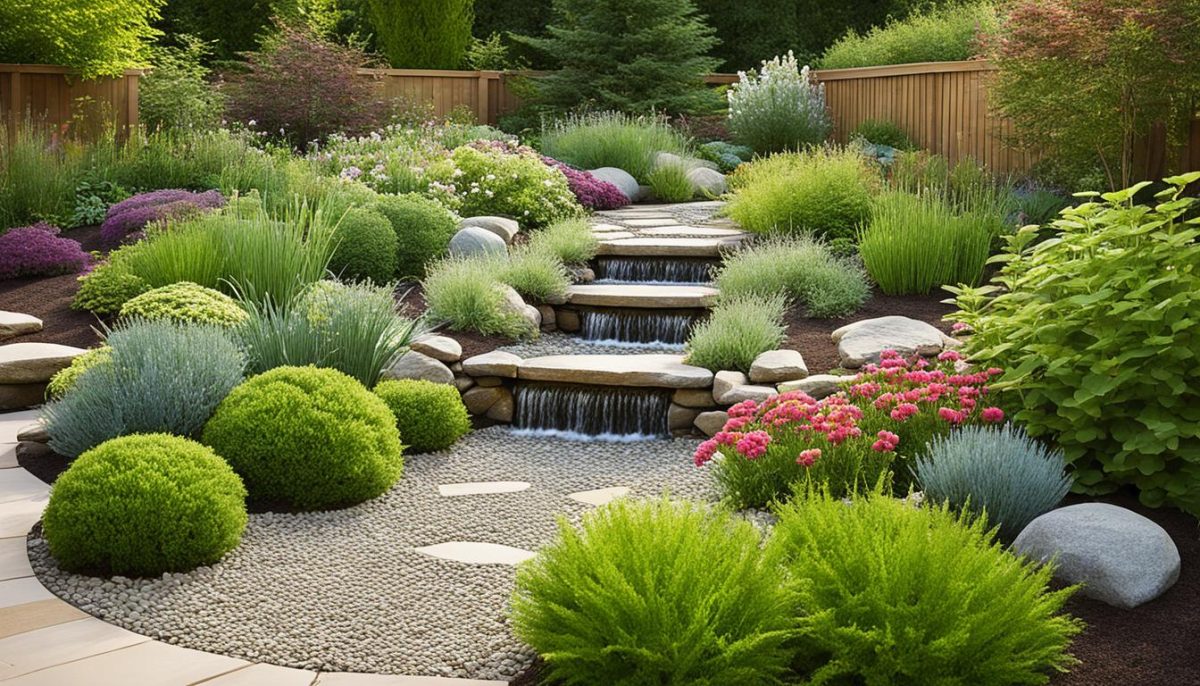
By implementing these low-maintenance landscaping design ideas, you can enjoy a beautiful outdoor space without the constant maintenance. From choosing the right plants to utilizing smart irrigation systems, there are plenty of options to simplify your outdoor upkeep while still maintaining the charm and beauty of your landscape.
Incorporating Water Features: Landscaping Design Ideas
Transform your outdoor space into a tranquil oasis by incorporating water features. The gentle flow of water not only adds a soothing ambiance but also enhances the overall aesthetic appeal of your landscape. In this section, we will explore creative landscaping design ideas that incorporate various water features, such as fountains, ponds, and waterfalls.
1. Fountains
Fountains are a classic choice for incorporating water features in your outdoor space. Whether it’s a large centerpiece fountain or a smaller wall-mounted one, fountains can add an elegant focal point to your landscape. The sound of cascading water creates a calming atmosphere and masks any unpleasant background noise.
2. Ponds
Designing a pond in your backyard allows you to create a serene and natural-looking water feature. From a small reflection pond to a larger water garden, ponds provide a habitat for aquatic plants and wildlife while offering a serene spot for relaxation. Consider adding fish or colorful water lilies to enhance the visual appeal of your pond.
3. Waterfalls
Nothing evokes a sense of serenity like the mesmerizing sound of a waterfall. Installing a waterfall can add a touch of luxury to your landscape design, creating a focal point that captures attention. Whether it’s a cascading waterfall into a pond or a wall-mounted waterfall feature, the sight and sound of flowing water will create a soothing and tranquil atmosphere in your backyard.
“The gentle flow of water in a landscape has a powerful effect on our well-being. Incorporating water features can elevate your outdoor space to a whole new level of relaxation and beauty.” – Landscaping Expert
When incorporating water features into your landscape design, ensure proper installation and maintenance to avoid any water wastage and ensure the longevity of the features. Consider using eco-friendly options such as recirculating pumps and rainwater collection systems to minimize water consumption.
Now, let’s take a closer look at some mesmerizing examples of how water features can be integrated into landscaping designs:
As you can see, water features can be integrated into various landscape designs, ranging from modern minimalist to lush and tropical. The key is to find a design that complements your existing outdoor space and enhances its natural beauty.
With the right choice and placement of water features, you can create a serene and inviting outdoor space that beckons you to relax and unwind. Let the gentle flow of water inspire tranquility in your landscape design.
Personalizing Your Outdoor Space: Landscaping Design Ideas
Your outdoor space is an extension of your home, and it should be a reflection of your unique style and personality. The good news is that there are countless landscaping design ideas that allow you to personalize your outdoor space and make it truly yours. Whether you have a small patio, a spacious backyard, or anything in between, there are various ways to infuse your own creativity into your landscape design.
One way to personalize your outdoor space is by incorporating custom features and artwork. This could be a custom-made sculpture, a mosaic-tiled pathway, or even a personalized garden gate. These unique elements can serve as focal points in your landscape, showcasing your personal taste and adding a touch of whimsy to the overall design.
If you have a specific theme or interest, why not create a themed garden? Whether you’re passionate about tropical plants, Japanese aesthetics, or a particular era, designing a garden that aligns with your interests can be a fun and fulfilling project. For example, a Zen garden with carefully raked gravel, minimalist plants, and a calming water feature can create a peaceful retreat for meditation and reflection.
Outdoor structures are another way to personalize your outdoor space. Consider adding a gazebo, pergola, or a cozy seating area with a fire pit. These structures not only add functionality to your outdoor space but also provide opportunities for personalization. You can choose the style, materials, and finishes that align with your taste and create a space that is uniquely yours.
Here is an example of how personalization can make a difference:
“I wanted to create a cozy outdoor space where my family and friends could gather and make memories. I incorporated a custom-built wooden seating area with plush cushions, string lights, and a rustic fire pit. It has become the perfect spot for summer barbecues and late-night conversations. Whenever I spend time there, I feel a sense of pride and joy knowing that I created a space that reflects who I am and what I love.” – Sarah, a homeowner who personalized her outdoor space
In conclusion, personalizing your outdoor space is all about infusing your own creativity and style into the landscape design. Whether you opt for custom features, themed gardens, or outdoor structures, let your outdoor space reflect who you are and create an environment that brings you joy and comfort.
Personalization Ideas for Your Outdoor Space
| Personalization Idea | Description |
|---|---|
| Custom Features | Add unique elements such as custom-made sculptures, mosaic-tiled pathways, or personalized garden gates. |
| Themed Gardens | Create a garden that aligns with your interests, such as a tropical garden, Japanese garden, or a garden inspired by a specific era or style. |
| Outdoor Structures | Incorporate structures like gazebos, pergolas, or seating areas with fire pits to create functional and personalized spaces. |
Remember, personalizing your outdoor space is an exciting opportunity to showcase your style and create an environment that truly feels like home.
Maximizing Curb Appeal: Landscaping Design Ideas
When it comes to making a great first impression, your front yard plays a crucial role. Luckily, there are plenty of landscaping design ideas that can help you maximize the curb appeal of your home. By incorporating these ideas, you can create an inviting and attractive front yard that will leave a lasting impression on your guests and passersby.
One of the key elements in enhancing curb appeal is maintaining a well-manicured lawn. Regular mowing, edging, and trimming can make a significant difference in the overall appearance of your front yard. Pair your lush, green lawn with vibrant flower beds filled with colorful blooms to add a pop of color and visual interest. Choose flowers that complement your home’s exterior and create a cohesive look.
In addition to a pristine lawn and flower beds, strategically placed landscape elements can further enhance your curb appeal. Consider adding a focal point, such as a stunning sculpture, an elegant fountain, or a charming bench, to create a visual centerpiece. Introduce hardscaping features like stone pathways or decorative borders to define and frame your front yard, adding structure and elegance to the overall design.
Remember, the key to maximizing curb appeal is to create a harmonious and balanced look that complements your home’s architecture. By following these landscaping design ideas, you can transform your front yard into a welcoming and captivating space that sets the tone for the rest of your home.

